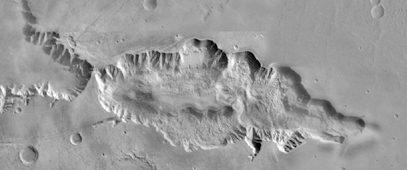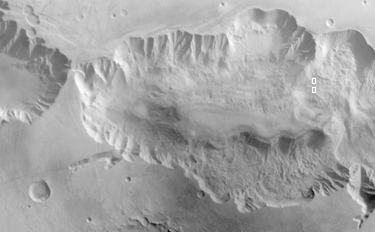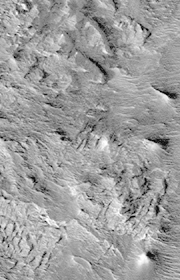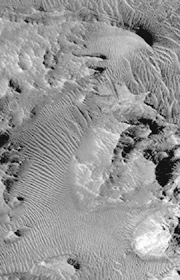
Mars Global Surveyor
Mars Orbiter Camera
Mars Orbiter Camera (MOC) High Resolution Images:
Sand Dunes and Landslide Debris on the Floor of Hebes Chasma
Mars Global Surveyor Mars Orbiter Camera Release: MOC2-31A, -31B, -31C, -31D
Mars Global Surveyor Mars Orbiter Camera Image ID: 563215926.3506
P035-06
(A)
 (A) Regional view of Hebes Chasma. Excerpt from U.S. Geological Survey Mars Digital
Image Mosaic, reproduced here (click on image) at a scale of about 540 meters
(0.25 miles) per pixel.
(A) Regional view of Hebes Chasma. Excerpt from U.S. Geological Survey Mars Digital
Image Mosaic, reproduced here (click on image) at a scale of about 540 meters
(0.25 miles) per pixel.
(B)
 (B) Portion of Viking Orbiter 1 image 645A60, reproduced at full resolution
(click on image), about 275 meters (899 feet) per pixel. The outlines of
(C) (upper box) and (D) (lower box) are shown. North is up, sun
illumination is from the right.
(B) Portion of Viking Orbiter 1 image 645A60, reproduced at full resolution
(click on image), about 275 meters (899 feet) per pixel. The outlines of
(C) (upper box) and (D) (lower box) are shown. North is up, sun
illumination is from the right.
(C)
 (C) Subframe-A of MOC image 3506 reproduced at full resolution, about 2
meters/pixel (6 feet/pixel). Picture shows an area approximately
2.3 x 3.6 km (1.4 x 2.2 miles) in size. Image is centered approximately
at 0.66°S, 76.03°W. Sun illumination is from lower left.
(C) Subframe-A of MOC image 3506 reproduced at full resolution, about 2
meters/pixel (6 feet/pixel). Picture shows an area approximately
2.3 x 3.6 km (1.4 x 2.2 miles) in size. Image is centered approximately
at 0.66°S, 76.03°W. Sun illumination is from lower left.
(D)
 (D) Subframe-B of MOC image 3506 reproduced at full resolution, about 2
meters/pixel (6 feet/pixel). Picture shows an area approximately
2.3 x 3.6 km (1.4 x 2.2 miles) in size. Image is centered approximately
at 0.80°S, 76.00°W. Sun illumination is from lower left.
(D) Subframe-B of MOC image 3506 reproduced at full resolution, about 2
meters/pixel (6 feet/pixel). Picture shows an area approximately
2.3 x 3.6 km (1.4 x 2.2 miles) in size. Image is centered approximately
at 0.80°S, 76.00°W. Sun illumination is from lower left.
You may need to adjust the images for the gamma of your monitor to
insure proper viewing.
|
Note: This MOC image is made available
in order to share with the public the excitement of new
discoveries being made via the Mars Global Surveyor spacecraft.
The image may be reproduced only if the
image is credited to "Malin Space Science Systems/NASA".
Release of this image does not constitute a release of
scientific data. The image and its caption should not be
referenced in the scientific literature. Full data releases
to the scientific community are scheduled by the Mars Global
Surveyor Project and NASA Planetary Data System. Typically, data
will be released after a 6 month calibration and validation period.
Click Here for more information on MGS data release and
archiving plans.
|
CAPTION
Sand dunes among landslide debris on the floor of Hebes Chasma. Hebes
Chasma is a large, enclosed depression related to the Valles Marineris
canyon system (see context images (A) and (B)). The two
subframes of MOC image #3506 (C & D) show some of the variety
of sand dunes that MOC has revealed on the canyon floor.
The first subframe (C) includes small hills composed of
landslide debris from the north wall of Hebes Chasma. Superposed on
the debris are two sets of dunes-- some with crests that run generally
east-west, and another, darker set of dunes with crests than run
approximately north-south.
The second subframe (D) shows a more visually interesting view
of additional dark (low albedo) sand dunes on the floor of Hebes
Chasma. On the basis of past work with Viking and Mariner Mars data,
dark dunes are thought to consist of sand derived from basaltic rocks
(e.g., like the black sand beaches in Hawaii, or the dark brown
sand dunes near Moses Lake, Washington). The Mars Global Surveyor
Thermal Emission Spectrometer team reported in
Science (v. 279, n. 5357, pp. 1692-1698, March 13, 1998)
that on this same orbit that the MOC images were obtained, the
spectrometer detected possible minerals pyroxene and
plagioclase in Hebes Chasma--common minerals in basaltic sands
on Earth.
MOC image #3506 was taken on November 5, 1997, at 8:52 AM PST, during
Mars Global Surveyor's 35th orbit around Mars.
The two MOC subframes of #3506 were featured in Figure 2
in Malin et al.,
"Early Views of the Martian Surface from the Mars Orbiter Camera of Mars
Global Surveyor," Science, v. 279, no. 5357, pp. 1681-1685.
Malin Space Science Systems and the California Institute of
Technology built the MOC using spare hardware from the Mars Observer
mission. MSSS operates the camera from its facilities in San Diego,
CA. The Jet Propulsion Laboratory's Mars Surveyor Operations Project
operates the Mars Global Surveyor spacecraft with its industrial
partner, Lockheed Martin Astronautics, from facilities in Pasadena, CA
and Denver, CO.
 To MSSS
Home Page
To MSSS
Home Page
Contact: info@msss.com

